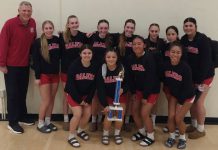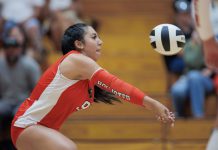Catching the Eyes of the PGA
Every year over 1,100 golfers enter PGA Tour qualifying tournaments – known as “Q-School” – nationwide with the hope of making it onto the tour, a goal only 30 of them will reach. The opening round of that journey takes place on 14 chosen courses from throughout the country.
This past weekend local golfer John Ellis, who attended Live Oak High School and Gavilan College before going on to play at Oregon, arrived at one such “Dream Course”, namely, one of South Valley’s own, San Juan Oaks Golf Club, a course of which he is well familiar, to take the first step in chasing that PGA dream.
Last year, Ellis came up one stroke short of advancing to the third and final stage of Q-School.
This year, he’s back, giving it another try.
Ellis, 25, shot a 16-under 272 over four rounds at a first stage tournament at San Juan Oaks Golf Club last week to qualify for the second stage. The 1998 Live Oak graduate finished tied for third place behind Michael Putnam of Tacoma, Wash. and Doug Garwood of Chatsworth, both of whom tied for first with a 271.
“It was tough today,” said Ellis after shooting a 5-under 67 on Friday in his last round. “But all week I’ve been hitting the ball good and had good course management. Overall, a good week of golf.”
Ellis will play in the second stage tournament at Bayonet Golf Course in Seaside Nov. 16-19.
Like many of the golfers that enter Q-School competition, golf is a full-time job for Ellis, which is why the tournaments’ stakes are so high. Players who don’t make it have to wait another full year for another shot.
“The most typical (Q-School) player is a young player trying to break into the PGA Tour who was typically a good college player,” said San Juan Oaks general manager Scott Fuller . “But you also get players who have been on tour and not maintained their status to be on the tour.”
PGA Tour golfers have to earn a certain amount of money to stay on the tour. If they don’t, they are dropped.
Casey Martin, the golfer who is best known for suing the PGA Tour for the right to ride a cart because of a degenerative circulatory disease, was one of those playing to get back on the tour. Martin didn’t qualify, finishing tied for 46th with a 2-over total score of 290.
It’s the third time that San Juan Oaks been bestowed the honor, chosen by the PGA, to host a first stage tournament. First stage events were held there in 2002 and last year.
And while San Juan Oaks has never hosted an actual PGA event, in the late ’90’s Fuller said Fred Couples, John Daly, Craig Stadler and John Cook played in a skins event at the course.
“The PGA Tour was looking for a course (to host a Q-School tournament) in our region,” Fuller said. “They viewed it a lot and thought it was a good setup.”
But with being chosen comes a responsibility. Fuller said that although the course, California’s first Couples signature course, is usually maintained to high standards by the grounds crew, the PGA demands even more.
“(Superintendent) Brad Langley and his crew normally maintain the course at a high level,” Fuller said. “But the PGA has tour requirements beyond that.”
Those requirements range from the speed of the greens to the height the fairway should be mowed, small details that mean a lot in a tournament where players’ futures can depend on a single stroke.
Because he lives in San Jose, Ellis had a chance to play San Juan Oaks a few times before the actual Q-School tournament. It was a luxury most of his competition didn’t have. All but two of the field traveled from outside the Bay Area, many coming from other states.
“I know (the course) probably more than most people here,” Ellis said. “It’s definitely an advantage.”
Fuller hopes the PGA will choose San Juan Oaks again next year for its third consecutive year as a first stage tournament site.
“It’s sort of nice for the area a lot of the players that come in from out of town eat at local restaurants and stay at local hotels,” Fuller said. “It’s a little bit of an economic boost in the area.”









